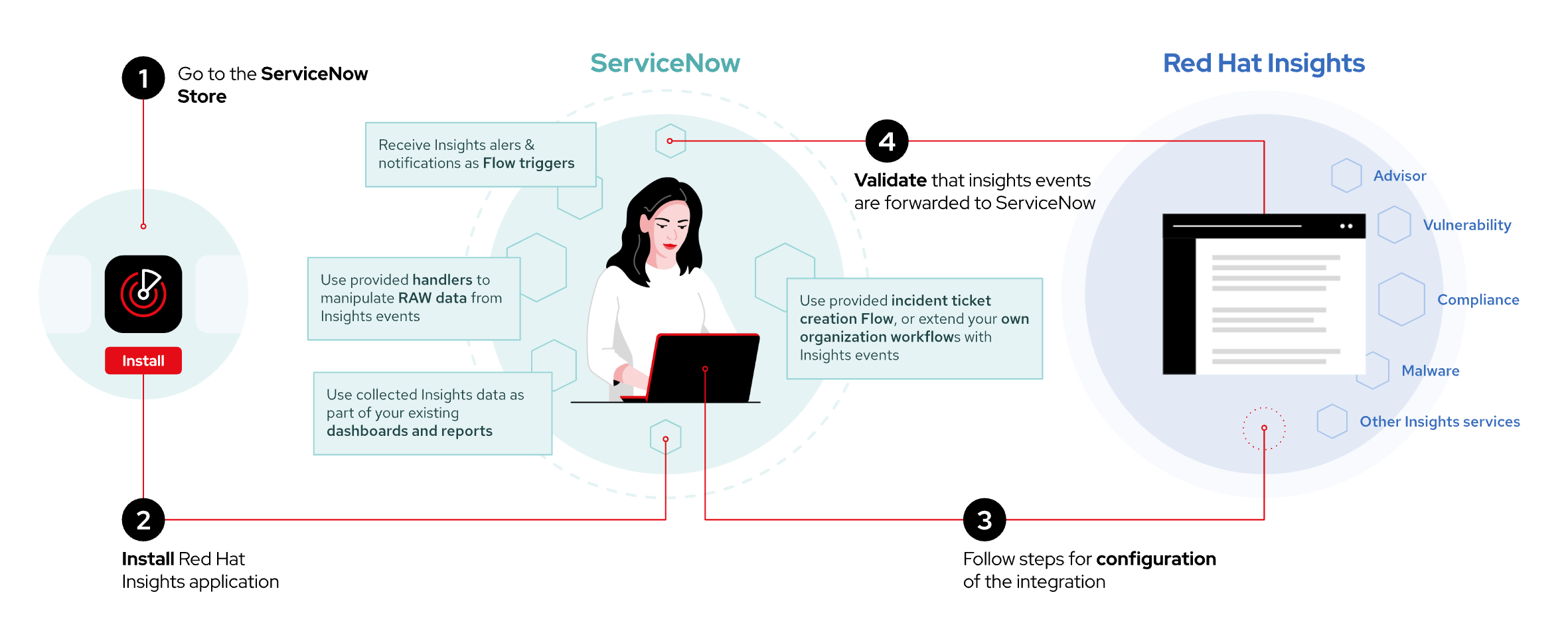More and more companies today use unstructured work patterns in their day-to-day management of operations. Tools are proliferating and often solve unique problems, resulting in many different applications, user interfaces (UIs) and processes that must be managed and maintained simultaneously. In response to these challenges, we find our users turning to integration and intelligent automation to create smarter operational workflows for a more efficient and connected enterprise.
We are now introducing new capabilities for Red Hat Insights to integrate Red Hat findings into ServiceNow workflows. The main goal is to offer ways for users to consolidate their operations and management and obtain greater value from combined platforms. The proposed integration is the foundation for additional extensions and automation based on each organization’s needs.
ServiceNow offers Software-as-a-Service (SaaS) products for technical management support in the form of managed workflows such as IT services management (ITSM), IT operations management (ITOM) and IT business management (ITBM). These tools allow organizations to manage projects, teams and customer interactions with a variety of apps and plugins. ServiceNow provides an app store that lists third-party tool offerings from partners.
Insights continuously analyzes platforms and applications to help predict risk, recommend actions and track costs so enterprises can better manage their hybrid cloud environments.
Red Hat Insights integration with ServiceNow
We recently published an overview of the Insights integration capabilities. Organization administrators can embed Insights as part of their workflows and automate using Insights API queries (see cheatsheet and API documentation) or HTTP POST requests to webhook endpoints. We recently announced a bespoke application integration for Splunk. Extending our integration capabilities, the new Flow Templates for Red Hat Insights application for ServiceNow falls in this category and follows a similar approach.
Once installed and enabled in your environment, the application allows your ServiceNow instance to receive events in JSON format from Insights and triggers flow(s) with bespoke actions based on the event’s data. For example, one of the provided sample flows results in the creation of a ServiceNow incident ticket, with all relevant associated information, on the reception of a vulnerability event trigger from Insights.
First, go to the ServiceNow App Store (Step 1), and install the certified Flow Templates for Red Hat Insights application (Step 2). The installation guide instructs the ServiceNow administrator to create a dedicated rh_insights_integration for the Insights integration on the ServiceNow side and expose an HTTP endpoint so that Insights can forward events.
This endpoint is used in the flow as a REST API trigger, which accepts token-based authentication. With this set up, you can proceed to the configuration of the integration in Insights (Step 3). This consists of creating a new ServiceNow integration and associated behavior group, and selecting which of the Insights events to forward (Step 4). This process is facilitated by a wizard within Insights, and is fully covered in the product documentation.
Once installed and configured, your ServiceNow instance is ready to start receiving a stream of selected Insights events (e.g. New Recommendation from Advisor, New Vulnerability with Critical Severity from Vulnerability, etc, as selected as part of the behavior group creation).
The installed flow handles the reception of all Insights events and provides specific data handlers for Advisor and Vulnerability events. These consist of parsing the event metadata according to the schema and extracting relevant information. As an example, we use this data as input for the creation of a ServiceNow incident ticket. The flow can easily be duplicated, expanded or reused as part of your existing organization’s workflows.
Customizing Flow Templates for Red Hat Insights
The installed application contains a couple of actions specific to the handling of Insights events. In the example below, we check the type of event received using conditions and parse the content of each event with a specific handler. The outcome is then used to create a new incident record using existing ServiceNow actions. This flow serves as an example of what can be achieved, and provides the end-to-end steps to handle the reception of Insights events in ServiceNow flows.

The newly created incident ticket contains all relevant Insights data according to the handler. This can also be enhanced according to your needs. ServiceNow provides a wide range of Spokes with pre-built flows and actions to automate your integrations. These can easily be utilized within the Flow Designer by editing the provided flow template.
Getting started and follow-up
The certified Flow Templates for Red Hat Insights application is now available as Service Preview on the ServiceNow App Store. Search for ‘Red Hat Insights’ to find and install the application on your ServiceNow instance, and follow the installation guide instructions for the configuration.
This is the first certified Red Hat Insights application for ServiceNow. We hope this is relevant to you and benefits the integration of Red Hat Insights in your operational workflows. Our goal is to provide you with a complete end-to-end example of the integration capabilities so that you can replicate or reuse the steps in your own automation flows.
To learn more about Red Hat Insights and its integration capabilities, we recently hosted a Red Hat webinar covering this topic, which is now available on demand: Integrate system data and Insights knowledge into your existing tools and processes.
We are constantly looking for feedback to improve our products. If you have suggestions or questions about Red Hat Insights integrations, feel free to reach out to us using the Red Hat Customer Portal feedback form.
저자 소개
Jerome Marc is a Red Hat Sr. Principal Product Manager with over 15 years of international experience in the software industry spanning product management and product marketing, software lifecycle management, enterprise-level application design and delivery, and solution sales.
채널별 검색
오토메이션
기술, 팀, 인프라를 위한 IT 자동화 최신 동향
인공지능
고객이 어디서나 AI 워크로드를 실행할 수 있도록 지원하는 플랫폼 업데이트
오픈 하이브리드 클라우드
하이브리드 클라우드로 더욱 유연한 미래를 구축하는 방법을 알아보세요
보안
환경과 기술 전반에 걸쳐 리스크를 감소하는 방법에 대한 최신 정보
엣지 컴퓨팅
엣지에서의 운영을 단순화하는 플랫폼 업데이트
인프라
세계적으로 인정받은 기업용 Linux 플랫폼에 대한 최신 정보
애플리케이션
복잡한 애플리케이션에 대한 솔루션 더 보기
가상화
온프레미스와 클라우드 환경에서 워크로드를 유연하게 운영하기 위한 엔터프라이즈 가상화의 미래

